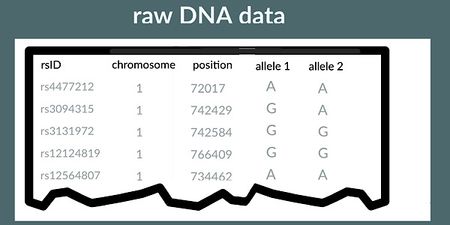How to check DNA data for certain genes
This article is a stub. |
Simple genetic testing services like those from 23andMe and Ancestry DNA provide you with raw genetic data, and this data can be opened and examined to see if you have certain gene variants or mutations, for instance those more likely to be found in people with ME/CFS, or for other issues like food sensitivities including lactose intolerance.
Get a DNA test[edit | edit source]
- Simple home based saliva tests are available from companies like 23andMe and Ancestry DNA, which provide results to an account the person create with them on the internet.
- The person spits into a tube and posts it, and some weeks later they are notified that their data is ready for them on the company's website.
- Companies typically profile some free analysis, such as which counties or areas your ancestors are most likely to have come from.
- There will be an option to download your "raw data". This is a very large, human readable and computer readable file. They advice you to keep it very secure. If you can't find the option for this look in the "Help" area on the website of the company that analysed your data.
- There are often options to pass more for a more detailed health report. Due to a lack of studies, the science is unclear with ME/CFS due to a limited number of studies, and very recent studies may not be included, so this may not be what you might hope for. It may cover well-known illnesses with a genetic link such as breast cancer or Parkinson's disease.
Opening the DNA data file[edit | edit source]
Some steps here have easier ways to do this, for instance on 23andMe you can search for a particular gene graphically.[1]
Basic steps[edit | edit source]
- Download the raw data file and save it. This is likely to be a .zip - a compressed file
- Unzip the file to access the uncompressed DNA file by double-clicking on it. Save any files and folders shown.
- Look inside what you downloaded for the raw DNA file - typically a text file (.txt)
- Either open the file in Excel and choose tab-delimited file or double-click on the file to open in a text editor. It may be a little slow to open since it's a large file.
Understanding the raw data[edit | edit source]
The raw DNA will have many different lines in the file.

Gene variants[edit | edit source]
Each gene variant (mutation) has an ID number assigned to it, beginning with rs, e.g., rs4988235.
Chromosome, genotype and alleles[edit | edit source]
Besides this rs ID, there the position, chromosome, and the genotype (made up of two are alleles, which are letters e.g., GG, TA, AT). Letters for the alleles are restricted to A, C, G and T.
Example: Lactose intolerance[edit | edit source]
For example, this is the information you need to look for to work out if you are likely to have lactase persistent or the opposite: lactose intolerance.
You may not have all of these variants, and for variants you do have some parts of alleles (A, C, G or T) may not be the ones listed.
| Gene | ID | Alleles | Notes |
|---|---|---|---|
| Example | Example | Example | Example |
| Example | Example | Example | Example |
| Example | Example | Example | Example |
| Example | Example | Example | Example |
| Example | Example | Example | Example |
| Example | Example | Example | Example[2][3] |
What to look for[edit | edit source]
Lactose intolerance is associated with LCT and MCM6 genes.[3]
Europeans populations
- rs4988235 (T) and rs182549 (A) alleles, form a haplotype predicting lactase persistence (thus avoiding lactose intolerance) in 77% of Europeans studied.
Sub-Saharan African populations
- rs145946881, known as "G/C-14010", is associated with lactase persistence in
- rs41380347 T/G(-13915) is less associated.
- rs41525747 C/G(-13907) is also less associated.
Other ethic backgrounds
It is typical to have only results from some populations, so while it might be possible to have the gene variants above, it could be that there are others more relevant to you. Genetic analysis is based on findings from current research, which is added to regularly.[2]
Lactose intolerance is considered "normal" in the human population, affecting around 65% of the population worldwide, so "lactase persistence", meaning the ability to properly digest dairy and lactose products after infancy is what is considered a "mutation".[3] If none of the lactase persistence variants listed are present then it means you are highly likely to have lactose intolerance, and can only digest limited amounts of dairy dairy or lactose before experiencing symptoms.[2]
Lactose intolerance is strongly linked to ancestry, for example just 8% of people in the [[United Kingdom|UK) have lactose intolerance, compared to 70-100% of people from East Asia, and many people of West African, Arab, Jewish, and South European (e.g., Greek or Italian) descent.
Understanding the results[edit | edit source]
See also[edit | edit source]
- ME/CFS Gene Study
- ME/CFS Severely Ill, Big Data Study
- Metabolic trap
- Indoleamine-2,3-dioxygenase 1 (IDO1)
- 23andMe
- Ancestry DNA
- Genetic Genie
- Genetic testing
Learn more[edit | edit source]
- Navigating Your Raw Data - 23andME
- Best raw data upload websites
- Genetics Home Reference - Lactose intolerance
- SNPedia - find the ID numbers (rs numbers) for different genes, and what research each gene is linked to
References[edit | edit source]
- ↑ "Navigating your raw data". 23andMe. Retrieved April 11, 2021.
- ↑ 2.0 2.1 2.2 2.3 "Lactose intolerance". snpedia.com. Retrieved April 11, 2021.
- ↑ 3.0 3.1 3.2 "Lactose intolerance: MedlinePlus Genetics". Genetics Home Reference. Retrieved April 11, 2021.

